check engine Lancia Ypsilon 2001 Owner handbook (in English)
[x] Cancel search | Manufacturer: LANCIA, Model Year: 2001, Model line: Ypsilon, Model: Lancia Ypsilon 2001Pages: 191, PDF Size: 2.45 MB
Page 84 of 191
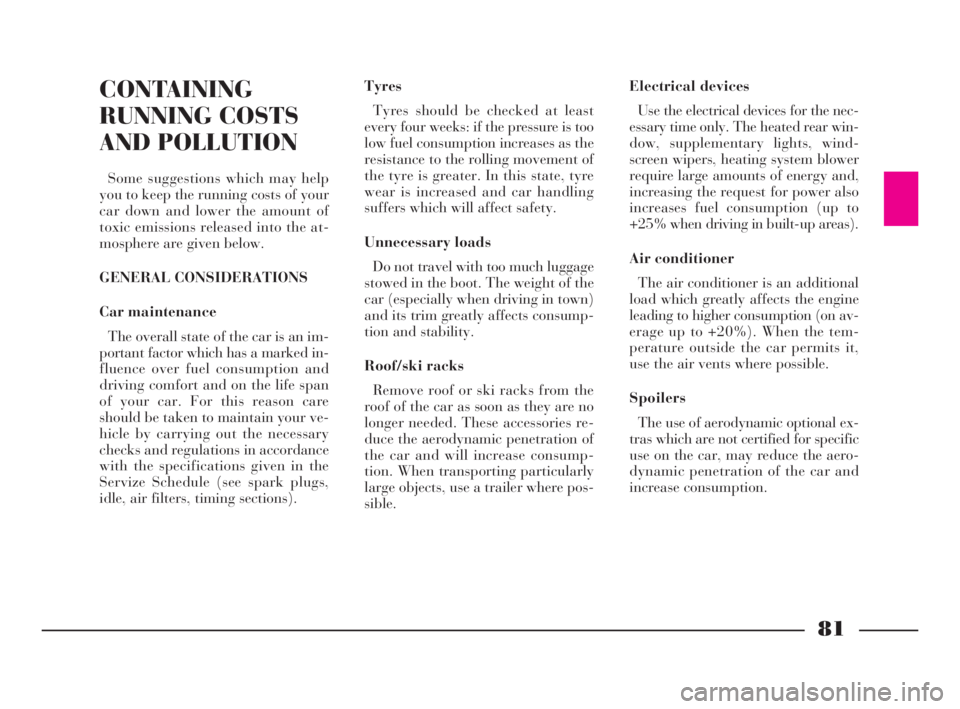
81
G
CONTAINING
RUNNING COSTS
AND POLLUTION
Some suggestions which may help
you to keep the running costs of your
car down and lower the amount of
toxic emissions released into the at-
mosphere are given below.
GENERAL CONSIDERATIONS
Car maintenance
The overall state of the car is an im-
portant factor which has a marked in-
fluence over fuel consumption and
driving comfort and on the life span
of your car. For this reason care
should be taken to maintain your ve-
hicle by carrying out the necessary
checks and regulations in accordance
with the specifications given in the
Servize Schedule (see spark plugs,
idle, air filters, timing sections).Tyres
Tyres should be checked at least
every four weeks: if the pressure is too
low fuel consumption increases as the
resistance to the rolling movement of
the tyre is greater. In this state, tyre
wear is increased and car handling
suffers which will affect safety.
Unnecessary loads
Do not travel with too much luggage
stowed in the boot. The weight of the
car (especially when driving in town)
and its trim greatly affects consump-
tion and stability.
Roof/ski racks
Remove roof or ski racks from the
roof of the car as soon as they are no
longer needed. These accessories re-
duce the aerodynamic penetration of
the car and will increase consump-
tion. When transporting particularly
large objects, use a trailer where pos-
sible.Electrical devices
Use the electrical devices for the nec-
essary time only. The heated rear win-
dow, supplementary lights, wind-
screen wipers, heating system blower
require large amounts of energy and,
increasing the request for power also
increases fuel consumption (up to
+25% when driving in built-up areas).
Air conditioner
The air conditioner is an additional
load which greatly affects the engine
leading to higher consumption (on av-
erage up to +20%). When the tem-
perature outside the car permits it,
use the air vents where possible.
Spoilers
The use of aerodynamic optional ex-
tras which are not certified for specific
use on the car, may reduce the aero-
dynamic penetration of the car and
increase consumption.
4C068-089 ING 11-03-2008 11:59 Pagina 81
Page 91 of 191
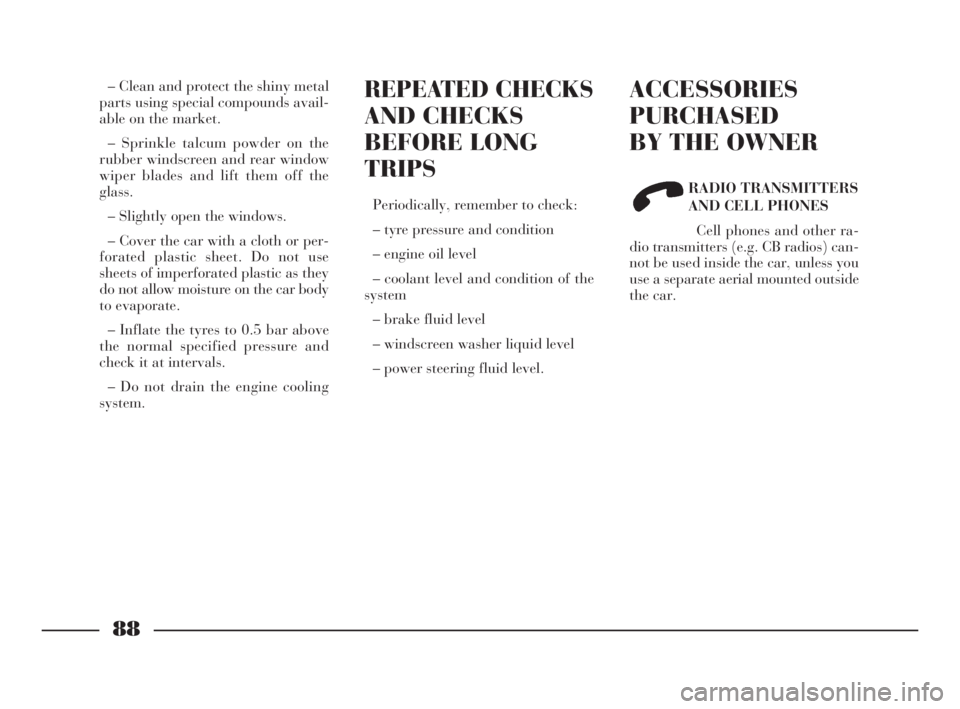
88
G
REPEATED CHECKS
AND CHECKS
BEFORE LONG
TRIPS
Periodically, remember to check:
– tyre pressure and condition
– engine oil level
– coolant level and condition of the
system
– brake fluid level
– windscreen washer liquid level
– power steering fluid level.
ACCESSORIES
PURCHASED
BY THE OWNER
RADIO TRANSMITTERS
AND CELL PHONES
Cell phones and other ra-
dio transmitters (e.g. CB radios) can-
not be used inside the car, unless you
use a separate aerial mounted outside
the car.
– Clean and protect the shiny metal
parts using special compounds avail-
able on the market.
– Sprinkle talcum powder on the
rubber windscreen and rear window
wiper blades and lift them off the
glass.
– Slightly open the windows.
– Cover the car with a cloth or per-
forated plastic sheet. Do not use
sheets of imperforated plastic as they
do not allow moisture on the car body
to evaporate.
– Inflate the tyres to 0.5 bar above
the normal specified pressure and
check it at intervals.
– Do not drain the engine cooling
system.
4C068-089 ING 11-03-2008 11:59 Pagina 88
Page 99 of 191

96
G
Never fit a standard tyre to a rim
to be used for the space-saver
spare wheel. Have the punctured
tyre repaired and fitted back on as
soon as possible.
No more than one space-saver
spare wheel must be used at the
same time.
Do not grease the bolt threads be-
fore fitting them, they could un-
screw themselves.
The jack must only be used to
change wheels on the vehicle with
which it is supplied or on vehicles
of the same model. All other uses,
for example raising other vehicles,
must be excluded. Under no cir-
cumstances use the jack to carry
out repairs under the vehicle.
If the jack is not used correctly,
the raised vehicle may fall.Do not use the jack to lift weights
above that indicated on the label
attached to the jack itself.
Never start the engine while the
car is raised by the jack. If travel-
ling with a trailer, detach the
trailer before raising the car.
Snow chains cannot be fitted to
the spare wheel, consequently if a
front tyre is punctured (front drive)
and snow chains need to be fitted,
a standard wheel must be removed
from the back axle and the space-
saver spare wheel fitted in its
place. In this way there will be two
standard wheels on the front and
the snow chains can be fitted.
Incorrect fitting of the wheel hub
could result in the hub coming off
when the vehicle is travelling.Never tamper with the inflation
valve.
Do not insert any type of tool be-
tween the rim and the tyre.
Periodically check the tyre pres-
sure including that of the spare-
saver spare wheel as per the val-
ues given in “Technical Specifica-
tions”.
fig. 3
P4C00401
fig. 2
P4C00400
4C090-119 ING 11-03-2008 12:00 Pagina 96
Page 116 of 191
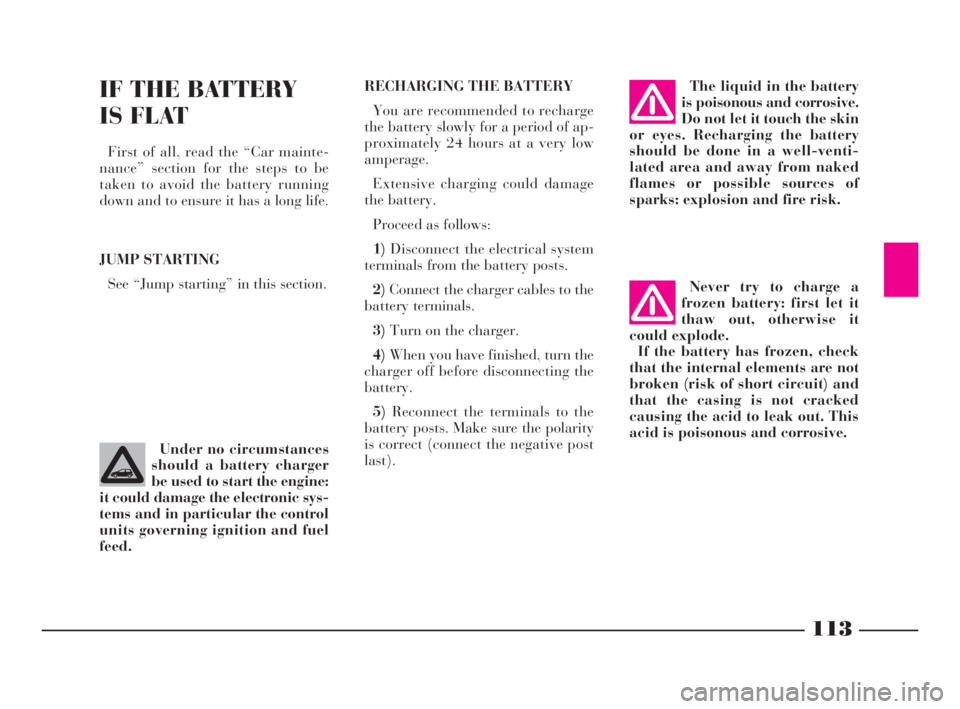
113
fG
RECHARGING THE BATTERY
You are recommended to recharge
the battery slowly for a period of ap-
proximately 24 hours at a very low
amperage.
Extensive charging could damage
the battery.
Proceed as follows:
1)Disconnect the electrical system
terminals from the battery posts.
2)Connect the charger cables to the
battery terminals.
3)Turn on the charger.
4)When you have finished, turn the
charger off before disconnecting the
battery.
5)Reconnect the terminals to the
battery posts. Make sure the polarity
is correct (connect the negative post
last).IF THE BATTERY
IS FLAT
First of all, read the “Car mainte-
nance” section for the steps to be
taken to avoid the battery running
down and to ensure it has a long life.
JUMP STARTING
See “Jump starting” in this section.The liquid in the battery
is poisonous and corrosive.
Do not let it touch the skin
or eyes. Recharging the battery
should be done in a well-venti-
lated area and away from naked
flames or possible sources of
sparks: explosion and fire risk.
Never try to charge a
frozen battery: first let it
thaw out, otherwise it
could explode.
If the battery has frozen, check
that the internal elements are not
broken (risk of short circuit) and
that the casing is not cracked
causing the acid to leak out. This
acid is poisonous and corrosive.
Under no circumstances
should a battery charger
be used to start the engine:
it could damage the electronic sys-
tems and in particular the control
units governing ignition and fuel
feed.
4C090-119 ING 13-03-2008 12:51 Pagina 113
Page 126 of 191
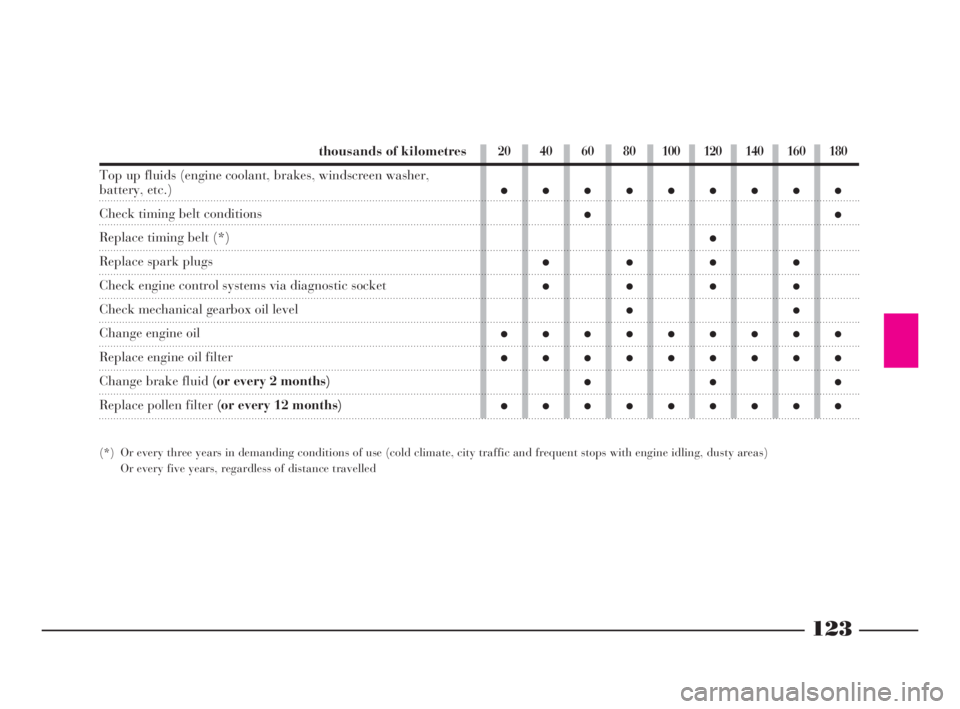
123
G
thousands of kilometres
Top up fluids (engine coolant, brakes, windscreen washer,
battery, etc.)
Check timing belt conditions
Replace timing belt (*)
Replace spark plugs
Check engine control systems via diagnostic socket
Check mechanical gearbox oil level
Change engine oil
Replace engine oil filter
Change brake fluid (or every 2 months)
Replace pollen filter (or every 12 months)
(*) Or every three years in demanding conditions of use (cold climate, city traffic and frequent stops with engine idling, dusty areas)
Or every five years, regardless of distance travelled
20 40 60 80 100 120 140 160 180
●●●●●●●●●
●●
●
●●●●
●●●●
●●
●●●●●●●●●
●●●●●●●●●
●●●
●●●●●●●●●
4C120-143 ING 11-03-2008 12:01 Pagina 123
Page 127 of 191

124
G
ADDITIONAL
CHECKS
Every 1000 kilometres or before
long trips, check and top up as neces-
sary:
– coolant level
– brake fluid level
– power steering fluid level
– windscreen washer liquid level
– tyre pressure and condition.
Every 3,000 kmcheck and top up
as necessary: engine oil level.
You are recommended to use
FL Groupproducts designed and pro-
duced specially for Lancia cars (see
the “Capacities” table in the “Tech-
nical specifications” section).
ANNUAL
INSPECTION
SCHEDULE
The following annual inspection
schedule is recommended for cars
travelling less than 20,000 km a year
(e.g. approximately 10,000 km). The
schedule includes the following oper-
ations:
– Check tyre condition and wear and
adjust pressure, if required (including
spare wheel).
– Check operation of lights (head-
lights, direction indicators, hazard
lights, boot light, passenger compart-
ment ceiling light, glove compartment
light, instrument panel lights, etc.).
– Check windscreen wiper/washer
and adjust nozzles.
– Check position/wear of wind-
screen/rear window wiper blades.
– Check front brake pad conditions
and wear.– Inspect conditions of. engine, gear-
box, transmission, piping (exhaust -
fuel feed - brakes), rubber parts (boots
- sleeves - bushings - etc.), brake and
fuel line hoses.
– Check battery charge status.
– Check conditions of various con-
trol belts.
– Check and top up fluid levels (en-
gine coolant, brakes, windscreen
washer, battery, etc.).
– Change engine oil.
– Replace engine oil filter.
– Replace pollen filter (where fitted).
4C120-143 ING 11-03-2008 12:01 Pagina 124
Page 128 of 191
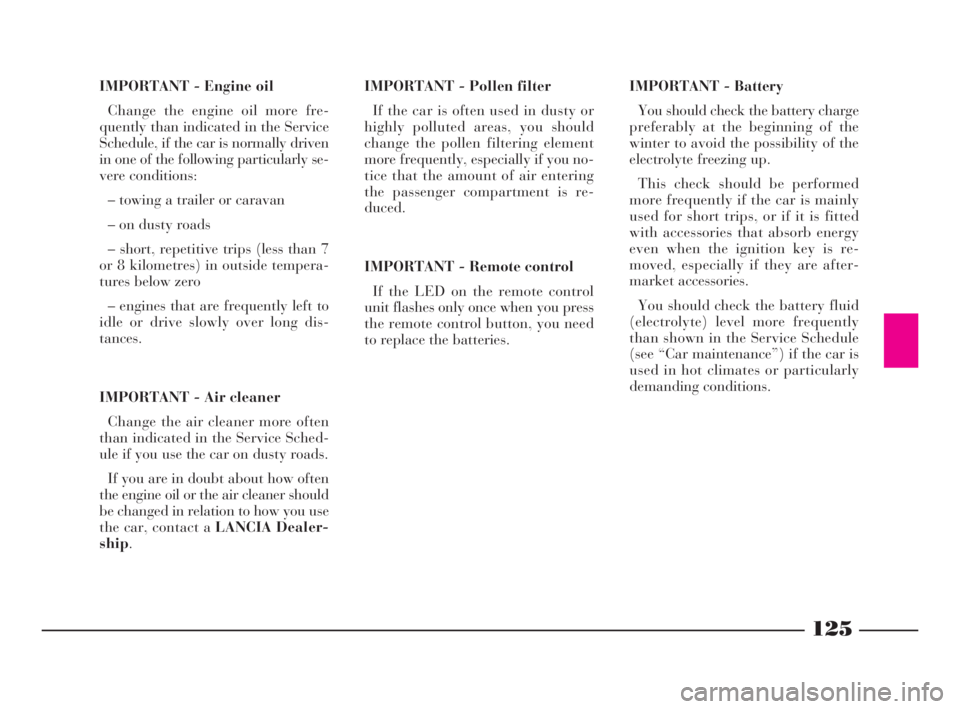
125
G
IMPORTANT - Battery
You should check the battery charge
preferably at the beginning of the
winter to avoid the possibility of the
electrolyte freezing up.
This check should be performed
more frequently if the car is mainly
used for short trips, or if it is fitted
with accessories that absorb energy
even when the ignition key is re-
moved, especially if they are after-
market accessories.
You should check the battery fluid
(electrolyte) level more frequently
than shown in the Service Schedule
(see “Car maintenance”) if the car is
used in hot climates or particularly
demanding conditions. IMPORTANT - Engine oil
Change the engine oil more fre-
quently than indicated in the Service
Schedule, if the car is normally driven
in one of the following particularly se-
vere conditions:
– towing a trailer or caravan
– on dusty roads
– short, repetitive trips (less than 7
or 8 kilometres) in outside tempera-
tures below zero
– engines that are frequently left to
idle or drive slowly over long dis-
tances.
IMPORTANT - Air cleaner
Change the air cleaner more often
than indicated in the Service Sched-
ule if you use the car on dusty roads.
If you are in doubt about how often
the engine oil or the air cleaner should
be changed in relation to how you use
the car, contact a LANCIA Dealer-
ship.IMPORTANT - Pollen filter
If the car is often used in dusty or
highly polluted areas, you should
change the pollen filtering element
more frequently, especially if you no-
tice that the amount of air entering
the passenger compartment is re-
duced.
IMPORTANT - Remote control
If the LED on the remote control
unit flashes only once when you press
the remote control button, you need
to replace the batteries.
4C120-143 ING 11-03-2008 12:01 Pagina 125
Page 130 of 191
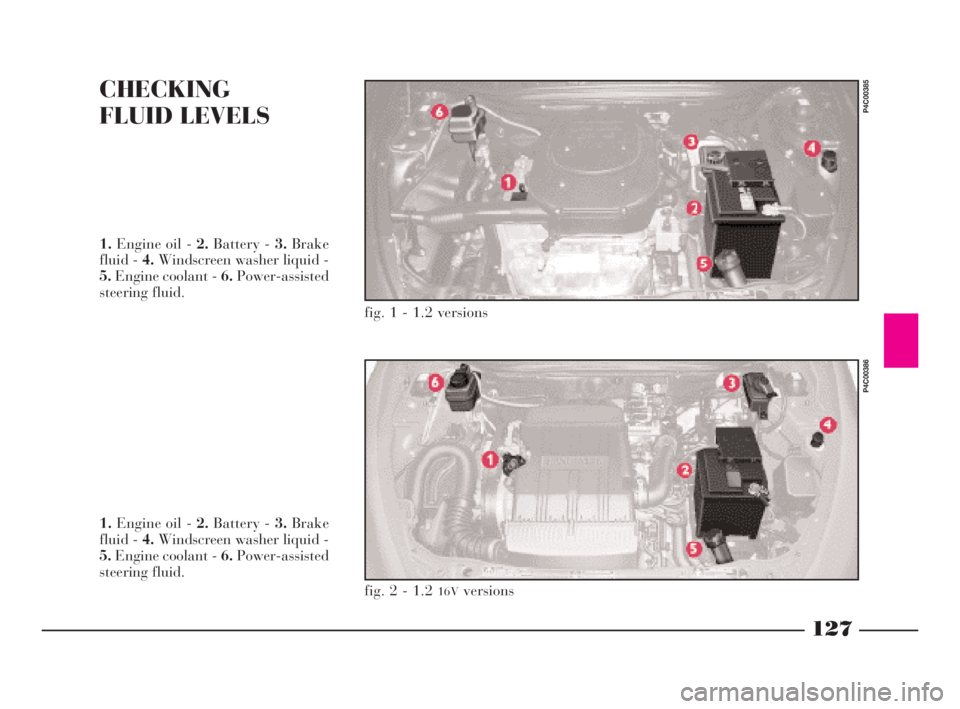
127
G
CHECKING
FLUID LEVELS
fig. 1 - 1.2 versions
P4C00385
1.Engine oil - 2.Battery - 3.Brake
fluid - 4.Windscreen washer liquid -
5.Engine coolant - 6.Power-assisted
steering fluid.
1.Engine oil - 2.Battery - 3.Brake
fluid - 4.Windscreen washer liquid -
5.Engine coolant - 6.Power-assisted
steering fluid.
fig. 2 - 1.2 16Vversions
P4C00386
4C120-143 ING 11-03-2008 12:01 Pagina 127
Page 131 of 191
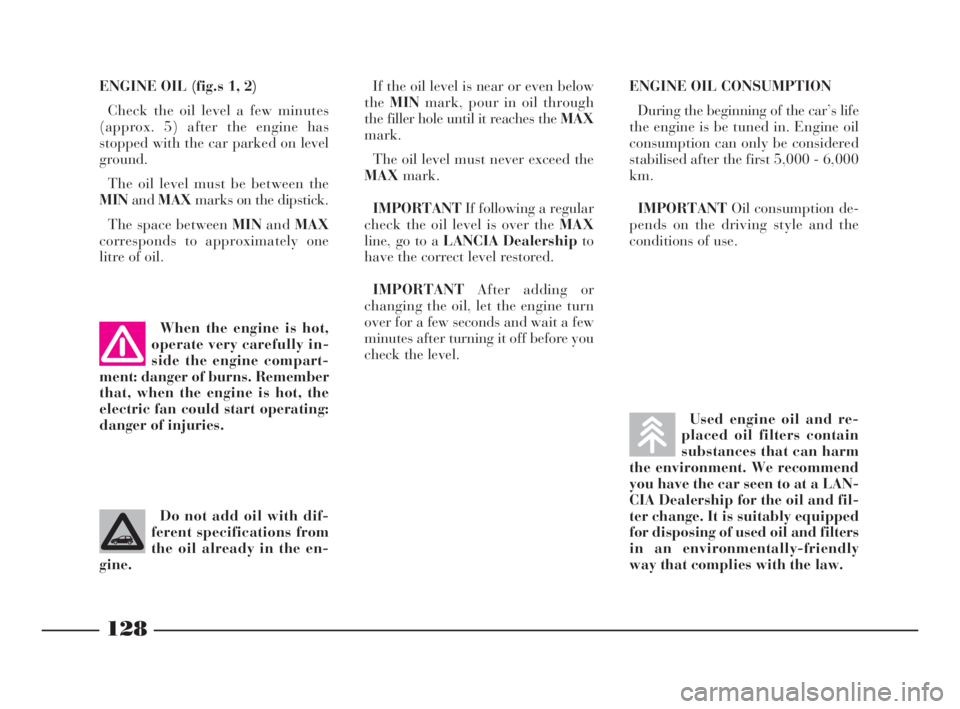
128
G
ENGINE OIL (fig.s 1, 2)
Check the oil level a few minutes
(approx. 5) after the engine has
stopped with the car parked on level
ground.
The oil level must be between the
MINandMAXmarks on the dipstick.
The space between MINandMAX
corresponds to approximately one
litre of oil.If the oil level is near or even below
theMINmark, pour in oil through
the filler hole until it reaches the MAX
mark.
The oil level must never exceed the
MAXmark.
IMPORTANTIf following a regular
check the oil level is over the MAX
line, go to a LANCIA Dealershipto
have the correct level restored.
IMPORTANTAfter adding or
changing the oil, let the engine turn
over for a few seconds and wait a few
minutes after turning it off before you
check the level.ENGINE OIL CONSUMPTION
During the beginning of the car’s life
the engine is be tuned in. Engine oil
consumption can only be considered
stabilised after the first 5,000 - 6,000
km.
IMPORTANTOil consumption de-
pends on the driving style and the
conditions of use.
When the engine is hot,
operate very carefully in-
side the engine compart-
ment: danger of burns. Remember
that, when the engine is hot, the
electric fan could start operating:
danger of injuries.
Do not add oil with dif-
ferent specifications from
the oil already in the en-
gine.
Used engine oil and re-
placed oil filters contain
substances that can harm
the environment. We recommend
you have the car seen to at a LAN-
CIA Dealership for the oil and fil-
ter change. It is suitably equipped
for disposing of used oil and filters
in an environmentally-friendly
way that complies with the law.
4C120-143 ING 11-03-2008 12:01 Pagina 128
Page 132 of 191

129
G
ENGINE COOLANT SYSTEM
(fig.s 1, 2)
IMPORTANTThe cooling system is
pressurised. If the plug must be re-
placed, replace it only with a genuine
spare part or system efficiency may be
impaired.
The coolant level must be checked
while the engine is cold and must be
between the MINandMAXmarks on
the reservoir.Do not take the cap of the
reservoir off when the en-
gine is very hot as you run
the risk of scalding yourself.
If there is not enough coolant, pour
a 50% mixture of distilled water and
FL Group PARAFLU
11liquid slowly
through the filler hole 5in the reser-
voir, until the level is near the MAX
mark.
A 50-50 mixture of PARAFLU
11
and distilled water gives freeze pro-
tection to –35 °C.WINDSCREEN/REAR WINDOW
WASHER LIQUID (fig.s 1, 2)
To add liquid, remove cap 4then
pour in the liquid until the reservoir
is completely full.
Use a mixture of water and DP1liq-
uid in these percentages:
30%DP1and 70% water in sum-
mer.
50%DP1and 50% water in winter.
If the temperature falls below –20°C,
useDP1undiluted.
IMPORTANTDo not travel with
the windscreen washer bottle empty:
using the windscreen washer is fun-
damental for improving visibility.
Some commercial addi-
tives for windscreen
washer fluids are flamma-
ble. The engine compartment con-
tains hot parts which could ignite
the fluid if it comes into contact
with them.
4C120-143 ING 11-03-2008 12:01 Pagina 129